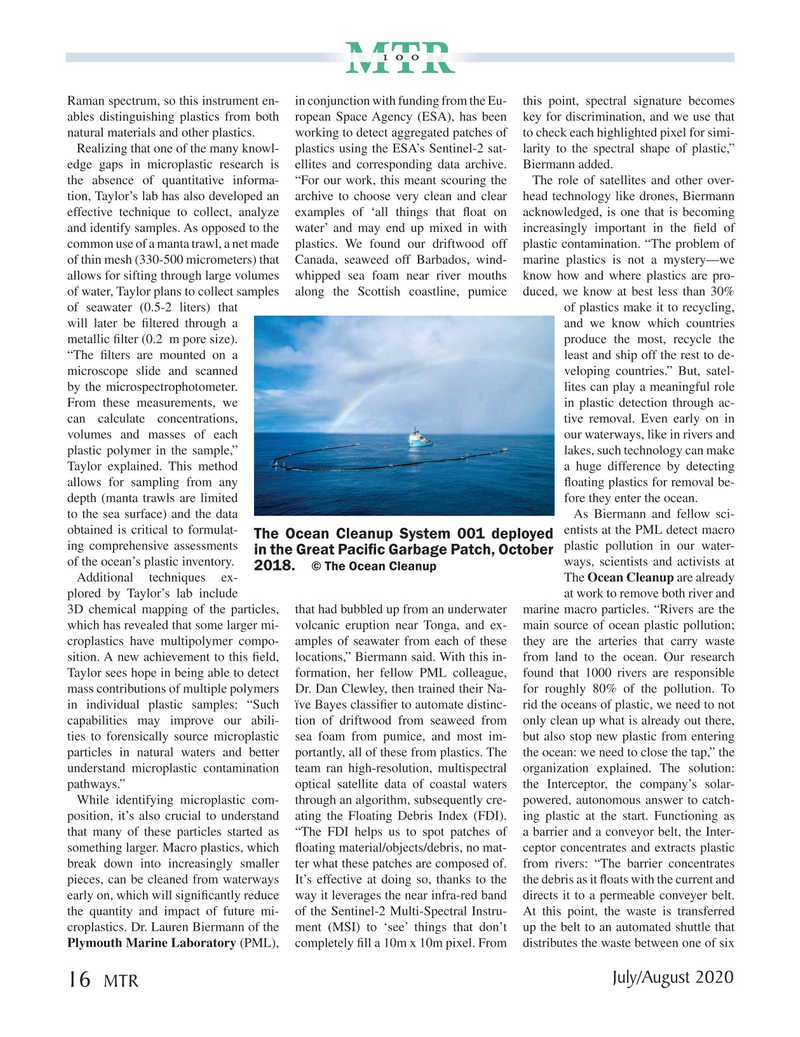
Page 16: of Marine Technology Magazine (July 2020)
Read this page in Pdf, Flash or Html5 edition of July 2020 Marine Technology Magazine
100
MTRMTR
Raman spectrum, so this instrument en- in conjunction with funding from the Eu- this point, spectral signature becomes ables distinguishing plastics from both ropean Space Agency (ESA), has been key for discrimination, and we use that natural materials and other plastics. working to detect aggregated patches of to check each highlighted pixel for simi-
Realizing that one of the many knowl- plastics using the ESA’s Sentinel-2 sat- larity to the spectral shape of plastic,” edge gaps in microplastic research is ellites and corresponding data archive. Biermann added. the absence of quantitative informa- “For our work, this meant scouring the The role of satellites and other over- tion, Taylor’s lab has also developed an archive to choose very clean and clear head technology like drones, Biermann effective technique to collect, analyze examples of ‘all things that ? oat on acknowledged, is one that is becoming and identify samples. As opposed to the water’ and may end up mixed in with increasingly important in the ? eld of common use of a manta trawl, a net made plastics. We found our driftwood off plastic contamination. “The problem of of thin mesh (330-500 micrometers) that Canada, seaweed off Barbados, wind- marine plastics is not a mystery—we allows for sifting through large volumes whipped sea foam near river mouths know how and where plastics are pro- of water, Taylor plans to collect samples along the Scottish coastline, pumice duced, we know at best less than 30% of seawater (0.5-2 liters) that of plastics make it to recycling, will later be ? ltered through a and we know which countries metallic ? lter (0.2 m pore size). produce the most, recycle the “The ? lters are mounted on a least and ship off the rest to de- microscope slide and scanned veloping countries.” But, satel- by the microspectrophotometer. lites can play a meaningful role
From these measurements, we in plastic detection through ac- can calculate concentrations, tive removal. Even early on in volumes and masses of each our waterways, like in rivers and plastic polymer in the sample,” lakes, such technology can make
Taylor explained. This method a huge difference by detecting allows for sampling from any ? oating plastics for removal be- depth (manta trawls are limited fore they enter the ocean. to the sea surface) and the data As Biermann and fellow sci- obtained is critical to formulat- entists at the PML detect macro
The Ocean Cleanup System 001 deployed ing comprehensive assessments plastic pollution in our water- in the Great Paci? c Garbage Patch, October of the ocean’s plastic inventory. ways, scientists and activists at 2018. © The Ocean Cleanup
Additional techniques ex- The Ocean Cleanup are already plored by Taylor’s lab include at work to remove both river and 3D chemical mapping of the particles, that had bubbled up from an underwater marine macro particles. “Rivers are the which has revealed that some larger mi- volcanic eruption near Tonga, and ex- main source of ocean plastic pollution; croplastics have multipolymer compo- amples of seawater from each of these they are the arteries that carry waste sition. A new achievement to this ? eld, locations,” Biermann said. With this in- from land to the ocean. Our research
Taylor sees hope in being able to detect formation, her fellow PML colleague, found that 1000 rivers are responsible mass contributions of multiple polymers Dr. Dan Clewley, then trained their Na- for roughly 80% of the pollution. To in individual plastic samples: “Such ïve Bayes classi? er to automate distinc- rid the oceans of plastic, we need to not capabilities may improve our abili- tion of driftwood from seaweed from only clean up what is already out there, ties to forensically source microplastic sea foam from pumice, and most im- but also stop new plastic from entering particles in natural waters and better portantly, all of these from plastics. The the ocean: we need to close the tap,” the understand microplastic contamination team ran high-resolution, multispectral organization explained. The solution: pathways.” optical satellite data of coastal waters the Interceptor, the company’s solar-
While identifying microplastic com- through an algorithm, subsequently cre- powered, autonomous answer to catch- position, it’s also crucial to understand ating the Floating Debris Index (FDI). ing plastic at the start. Functioning as that many of these particles started as “The FDI helps us to spot patches of a barrier and a conveyor belt, the Inter- something larger. Macro plastics, which ? oating material/objects/debris, no mat- ceptor concentrates and extracts plastic break down into increasingly smaller ter what these patches are composed of. from rivers: “The barrier concentrates pieces, can be cleaned from waterways It’s effective at doing so, thanks to the the debris as it ? oats with the current and early on, which will signi? cantly reduce way it leverages the near infra-red band directs it to a permeable conveyer belt. the quantity and impact of future mi- of the Sentinel-2 Multi-Spectral Instru- At this point, the waste is transferred croplastics. Dr. Lauren Biermann of the ment (MSI) to ‘see’ things that don’t up the belt to an automated shuttle that
Plymouth Marine Laboratory (PML), completely ? ll a 10m x 10m pixel. From distributes the waste between one of six
July/August 2020 16
MTR
MTR #6 (1-17).indd 16 8/13/2020 8:43:07 AM

 15
15

 17
17
